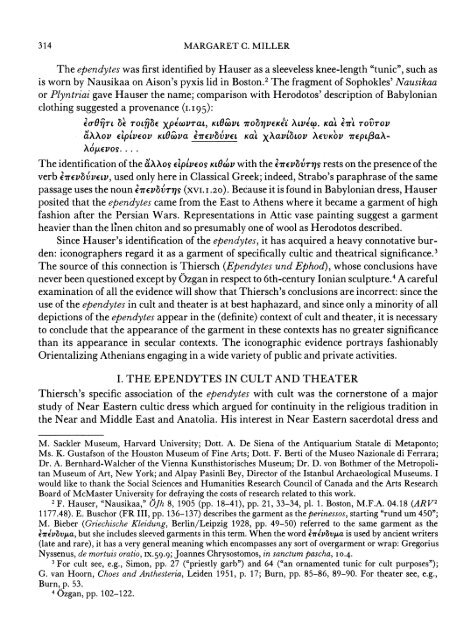the ependytes in classical athens - The American School of ...
the ependytes in classical athens - The American School of ...
the ependytes in classical athens - The American School of ...
You also want an ePaper? Increase the reach of your titles
YUMPU automatically turns print PDFs into web optimized ePapers that Google loves.
314 MARGARET C. MILLER<br />
<strong>The</strong> <strong>ependytes</strong> was first identified by Hauser as a sleeveless knee-length "tunic", such as<br />
is worn by Nausikaa on Aison's pyxis lid <strong>in</strong> Boston.2 <strong>The</strong> fragment <strong>of</strong> Sophokles' Nausikaa<br />
or Plyntriai gave Hauser <strong>the</strong> name; comparison with Herodotos' description <strong>of</strong> Babylonian<br />
cloth<strong>in</strong>g suggested a provenance (I. I95):<br />
EO7)TL<br />
83 TOt5EXpvTat, KLOW^OVL 3TO?VEKEL A?^LVE. Kat EIL TOVTOV<br />
ctAAov ELpLVEOV KLOCeJVa<br />
E7rEvVo5VEL Kat<br />
XoMuEvosx...<br />
A X<br />
vEVoV 7rELpt3aX-<br />
<strong>The</strong> identification <strong>of</strong> <strong>the</strong> aXXos pEt'vEos- KLOW'v with <strong>the</strong> E7T7rEv8vT?s- rests on <strong>the</strong> presence <strong>of</strong> <strong>the</strong><br />
verb EV 7rE3v8tVELV, used only here <strong>in</strong> Classical Greek; <strong>in</strong>deed, Strabo's paraphrase <strong>of</strong> <strong>the</strong> same<br />
passage uses <strong>the</strong> noun E'7rEV3V'T7S' (XVI. I .20). Because it is found <strong>in</strong> Babylonian dress, Hauser<br />
posited that <strong>the</strong> <strong>ependytes</strong> came from <strong>the</strong> East to A<strong>the</strong>ns where it became a garment <strong>of</strong> high<br />
fashion after <strong>the</strong> Persian Wars. Representations <strong>in</strong> Attic vase pa<strong>in</strong>t<strong>in</strong>g suggest a garment<br />
heavier than <strong>the</strong> l<strong>in</strong>en chiton and so presumably one <strong>of</strong> wool as Herodotos described.<br />
S<strong>in</strong>ce Hauser's identification <strong>of</strong> <strong>the</strong> <strong>ependytes</strong>, it has acquired a heavy connotative bur-<br />
den: iconographers regard it as a garment <strong>of</strong> specifically cultic and <strong>the</strong>atrical significance.3<br />
<strong>The</strong> source <strong>of</strong> this connection is Thiersch (Ependytes und Ephod), whose conclusions have<br />
never been questioned except by Ozgan <strong>in</strong> respect to 6th-century Ionian sculpture.4 A careful<br />
exam<strong>in</strong>ation <strong>of</strong> all <strong>the</strong> evidence will show that Thiersch's conclusions are <strong>in</strong>correct: s<strong>in</strong>ce <strong>the</strong><br />
use <strong>of</strong> <strong>the</strong> <strong>ependytes</strong> <strong>in</strong> cult and <strong>the</strong>ater is at best haphazard, and s<strong>in</strong>ce only a m<strong>in</strong>ority <strong>of</strong> all<br />
depictions <strong>of</strong> <strong>the</strong> <strong>ependytes</strong> appear <strong>in</strong> <strong>the</strong> (def<strong>in</strong>ite) context <strong>of</strong> cult and <strong>the</strong>ater, it is necessary<br />
to conclude that <strong>the</strong> appearance <strong>of</strong> <strong>the</strong> garment <strong>in</strong> <strong>the</strong>se contexts has no greater significance<br />
than its appearance <strong>in</strong> secular contexts. <strong>The</strong> iconographic evidence portrays fashionably<br />
Orientaliz<strong>in</strong>g A<strong>the</strong>nians engag<strong>in</strong>g <strong>in</strong> a wide variety <strong>of</strong> public and private activities.<br />
I. THE EPENDYTES IN CULT AND THEATER<br />
Thiersch's specific association <strong>of</strong> <strong>the</strong> <strong>ependytes</strong> with cult was <strong>the</strong> cornerstone <strong>of</strong> a major<br />
study <strong>of</strong> Near Eastern cultic dress which argued for cont<strong>in</strong>uity <strong>in</strong> <strong>the</strong> religious tradition <strong>in</strong><br />
<strong>the</strong> Near and Middle East and Anatolia. His <strong>in</strong>terest <strong>in</strong> Near Eastern sacerdotal dress and<br />
M. Sackler Museum, Harvard University; Dott. A. De Siena <strong>of</strong> <strong>the</strong> Antiquarium Statale di Metaponto;<br />
Ms. K. Gustafson <strong>of</strong> <strong>the</strong> Houston Museum <strong>of</strong> F<strong>in</strong>e Arts; Dott. F. Berti <strong>of</strong> <strong>the</strong> Museo Nazionale di Ferrara;<br />
Dr. A. Bernhard-Walcher <strong>of</strong> <strong>the</strong> Vienna Kunsthistorisches Museum; Dr. D. von Bothmer <strong>of</strong> <strong>the</strong> Metropolitan<br />
Museum <strong>of</strong> Art, New York; and Alpay Pas<strong>in</strong>li Bey, Director <strong>of</strong> <strong>the</strong> Istanbul Archaeological Museums. I<br />
would like to thank <strong>the</strong> Social Sciences and Humanities Research Council <strong>of</strong> Canada and <strong>the</strong> Arts Research<br />
Board <strong>of</strong> McMaster University for defray<strong>in</strong>g <strong>the</strong> costs <strong>of</strong> research related to this work.<br />
2 F. Hauser, "Nausikaa," OJh 8, 1905 (pp. 18-41), pp. 21, 33-34, pl. 1. Boston, M.F.A. 04.18 (ARV2<br />
1177.48). E. Buschor (FR III, pp. 136-137) describes <strong>the</strong> garment as <strong>the</strong> per<strong>in</strong>essos, start<strong>in</strong>g "rund um 450";<br />
M. Bieber (Griechische Kleidung, Berl<strong>in</strong>/Leipzig 1928, pp. 49-50) referred to <strong>the</strong> same garment as <strong>the</strong><br />
f7DEv8vlAa, but she <strong>in</strong>cludes sleeved garments <strong>in</strong> this term. When <strong>the</strong> word vE7rEv8v,a is used by ancient writers<br />
(late and rare), it has a very general mean<strong>in</strong>g which encompasses any sort <strong>of</strong> overgarment or wrap: Gregorius<br />
Nyssenus, de mortuis oratio, Ix.59.9; Joannes Chrysostomos, <strong>in</strong> sanctum pascha, IO.4.<br />
I For cult see, e.g., Simon, pp. 27 ("priestly- garb") and 64 ("an ornamented tunic for cult purposes");<br />
G. van Hoorn, Choes and An<strong>the</strong>steria, Leiden 1951, p. 17; Burn, pp. 85-86, 89-90. For <strong>the</strong>ater see, e.g.,<br />
Burn, p. 53.<br />
4 Ozgan, pp. 102-122.

















